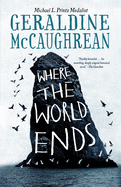
Winner of the 2018 Carnegie Medal, Geraldine McCaughrean's Where the World Ends is a gripping tale, set in 1727, about 12 men and boys clinging to life after being abandoned on a sheer vertical outcrop of rock in the frigid Atlantic Ocean.
Birds are the lifeblood of the 100 or so residents of Hirta island in the remote Scottish archipelago of St. Kilda. Every summer, a group of men and boys is dropped off at Warrior Stac, a steep rock column four miles from Hirta. For a few weeks, they live in inhospitable crevices and caves, descending on ropes from cliffs to harvest birds--waterfowl provide them with food, fuel and feathers for the winter ahead. At night, the caves are lit only by "the rigid oily little bodies of dead storm petrels threaded through with tarry wicks." To the group's growing dismay, weeks go by with no returning boat. When a devout boy has a vision that the end of the world has come and everyone but them has been taken up to heaven, some in the group panic. Others refuse to believe, and focus on surviving and signaling for help.
Based on a true story, Where the World Ends stuns with its dark narrative and haunting visual imagery: "Around them on every crevice of the rock walls, headless petrels burned, the wicks encircled by haloes of flame, as though a band of skinny little angels was peering down at them." Including illuminating back matter, like a glossary, and an illustrated list of the birds of 18th-century St. Kilda, McCaughrean's (The White Darkness; Peter Pan in Scarlet) work explores what happens when the everyday-ordinary turns disastrously extraordinary. --Emilie Coulter, freelance writer and editor

